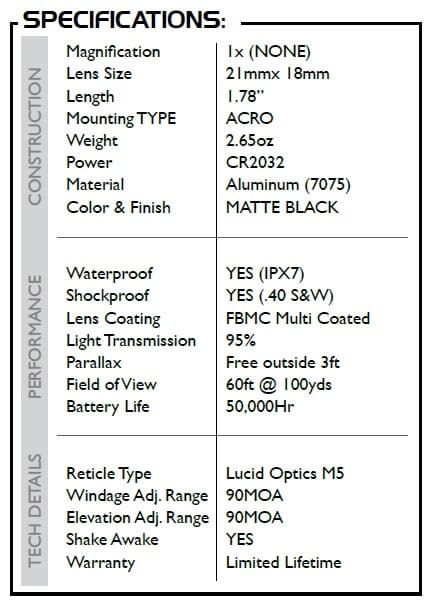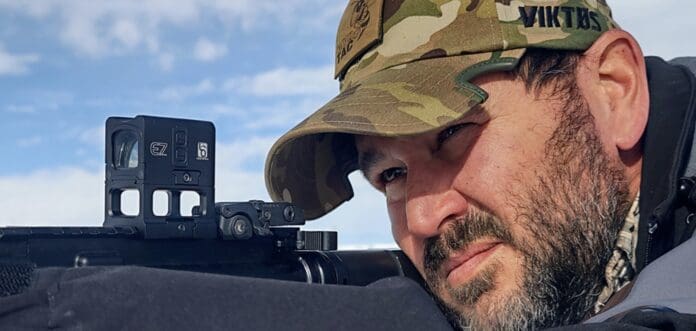Earlier this year, Lucid rolled out their new E7 enclosed emitter red dot sight. Now, in a first, they’re making a version of the E7 with a blue dot. While we’d been told that the human eye is most sensitive to green light, Lucid claims blue is the most effective color. We can’t wait to give that a try. Here’s Lucid’s press release . . .
Lucid Optics, a pioneer in cutting-edge optics technology, is proud to announce the launch of the E7 reflex sight with an innovative Blue Reticle. Staying true to our philosophy that “Overkill is Underrated,” the E7 takes durability and versatility to unprecedented heights, catering to both pistol and carbine applications.
The E7 will feature the worlds first reflex sight to employ an aiming point in BLUE. There is a Lot of science behind the use of blue as an aiming point. For more information on Why “BLUE” Please reach out to Lucid Optics Directly.

What Makes the Blue Reticle so Special?
• Blue is the fastest transmitted color in the spectrum.
• The Human eye is more sensitive to the blue wavelengths than any other in the spectrum.
• Blue illumination presents a clean edge reticle
• Blue is the most easily refracted wavelength by the human eye
• Blue Creates a “Circadian” rhythm, calming the human mind.
• Exposure to blue light considerably reduces stress levels.
• Less than .02% of people have a color blindness to Blue.
• Blue, as an illuminated aiming point, can be reduced in brightness level allowing the reticle to be “Seen Through” providing a more positive target identification.

As with all things Lucid Optics brings to the market, the E7 is Engineered to withstand the rigorous forces generated by most any firearm platform it is suited for. The E7 showcases the ACRO mounting system, offering unmatched adaptability across various platforms. This groundbreaking design opens up a world of possibilities for shooters seeking uncompromising performance.
“The E7 has undergone rigorous testing to prove its mettle in the face of punishing vibrations and extreme temperatures, characteristic of intense usage scenarios,” says Jason Wilson, President of Lucid Optics. “Equipped with a high-efficiency LED emitter, it features a razor-sharp M5 Reticle, proven to provide a 30% faster target acquisition compared to conventional dot sights of any color.”
The E7 is equally at ease as a primary optic on handguns and seamlessly transitions to defensive carbines and shotguns. Its compact size and exceptional versatility make it the perfect backup sight for magnified scopes and thermal imagers. With its vision compatibility, the E7 thrives in the most challenging environments, ensuring you never miss a beat.
One of the key advantages of Lucid Optics reflex sights is their operational parallax-free design. Regardless of the angle of your eye in relation to the field of view, the reticle always remains precisely on target, ensuring pinpoint accuracy with every shot.
The Lucid Optics E7 with Blue Reticle is set to redefine shooting precision and versatility in the world of optics. The Lucid Optics E7 has an MSRP of $299.99.

To learn more and see the full lineup of LUCID Optics products, visit www.lucidoptics.com.





Neat, probably cannot make as much use of it do to astigmatism but thank you to everyone that guided me to primary arms for the prism models, worked out great on a 1x.
Ass stig magnetism?
You poor bastard, is there anything I could do to help?
You must be hell on a compass
Helps guide the steel cored ammo, pity not I but the poor bastards relying on plastic derived body armor.
possum, you’ve heard of Magneto, right?
https://www.marvel.com/characters/magneto-max-eisenhardt/in-comics
That’s all fine and dandy however I do not think it would hold up to the abuse of being dragged behind me on my holster string
You should patent that holster design before someone steals the idea.
…. born with a pouch, utilizes a drag string. Mystery how you got stuck down there on the food chain ladder marsupial one.
Carry on
Girl Marsupials have the pouch.
Guy Marsupials spend the majority of their lives trying to burrow back in… 🙂
Now you’re assuming that possum’s a male. Kinda like assuming Debbie’s a female.
You know what they say about assuming.
Pb the pouch is for the reload.
@possum
String holster seemed to work for Tuco just fine.
[youtube https://www.youtube.com/watch?v=dBi_U3u1NeM&w=1056&h=594%5D
If you are a left-wing liberal the human eye is more sensitive to rainbow.
“…fastest transmitted color in the spectrum.” !!! By about 1 part in 100,000 under normal atmospheric conditions. And this is relevant because …?
As a guy with partial red/green color blindness…. thank you! Finally lol
thinking might use on .44 mag; but… Ehy does it say .40sw after shockproof?
So I found this out recently as my dept was looking to go to a RDS on our guns. Currently we have M&P 2.0 in 40 S&W. We were told by S&W that they won’t make slides in .40 cut for an optic because the recoil impulse kills optics. That’s the reason we are changing over to 9mm M&P 2.0 so we can mount Acro P-2.
Guessing by listing. 40 under shock proof, it can handle that sharp recoil impulse.
basically, in plain English and not science’ese – and because of the term ‘sensitive’ being used and can be applied in different contexts;
The human eye is ‘more able’ to see blue light in lower light conditions because the eye pupil opens more in lower light conditions thus, basically, more rods (basically light receptors) are ‘exposed’ and the rods contain a chemical (melanin) that is sensitive to blue light wave lengths but not other color light wave lengths. (note: this has nothing to do with human eye night vision ability). Blue light is also ‘transmitted’ faster than green light but the difference is so small that its not really perceived as a difference by the human brain-eye connection even though in some causes the eye may react quickly to some degree, but mathematically its about 1 part in 100,000. Blue light exposure provokes more of a photochemical reaction in most eye tissues, in particular the cornea, the lens, and the retina, than other light colors, this also is part of the ‘more able’.
The being ‘more able’ could be termed as ‘more sensitive’ in that context.
(note: melanin is sensitive to blue light because its the human eye filter defense against harmful blue light radiation. But not all blue light is harmful, only certain wavelengths are harmful and this sight does not use those wave lengths)
In bright conditions (e.g. sunlight, bright room light, etc…) and most low light conditions (e.g. bright moon light, shaded areas on sunny days, dark but ambient light enough to distinguish shapes and/or features) AND for distance the human eye is more sensitive’ to green because the cones (basically the receptors of the light wave lengths of color, there are around 6 million of these in a human eye) of the eye for the Long and Medium wavelengths (L and M – higher red frequencies and green wave lengths) are basically almost equally stimulated. This is actual ‘sensitive’.
So although it could be said, in its context of ‘more able’, “The Human eye is more sensitive to the blue wavelengths than any other in the spectrum.” and there is science to back this up and it is true because of the melanin and that any light of any wavelength hits the cornea of the eye before the cones …. the actual sensitive to light color is still green once the light color is perceived. The difference between green and blue in ‘perception’ and transmission is effectively zero because the human brain-eye connection can’t really perceive a difference when the light source is as close to the eye as it is with dot/scope sights, or at longer distances for the blue. So overall in effect, purpose, and money, and use in context with ‘sensitive’, the more correct statement would be “The Human eye is more sensitive to the green wavelengths than any other in the spectrum.” and a ‘green dot’ sight would still be better.
But of course, if you are red/green color blind or in some cases with aged eyes or eye problems where the red/green perception is affected or diminished some (and also for example, people who consume alcohol on a regular basis, or smoke tobacco or even pot, and some medications, or have medically related eye conditions can also suffer a diminishing of red/green color perception), then a ‘blue dot’ sight is probably/possibly going to be what you want.
Comments are closed.